Found objects can be used as mosaic tesserae based on their color and texture and shape, as another form of tile more or less, but found-objects of symbolic value add a whole new dimension to mosaics, one that is as cerebral as it is visual.
You do not have to choose between making a found-object mosaic or a figurative mosaic. You can create visual interest in figurative mosaics by using found-objects in a spare and selective way.
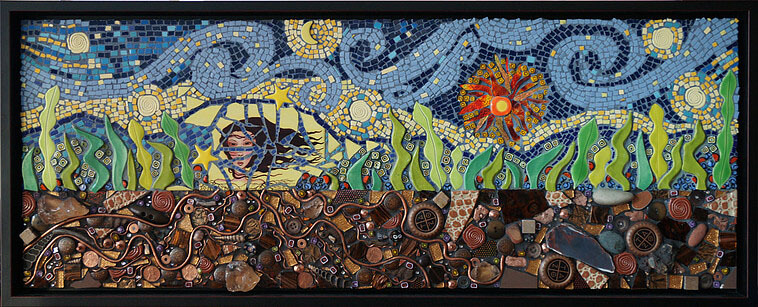
I wanted to show off and discuss artist Janet Sacks’ mosaics because she has some great examples of using found objects in figurative mosaic, both in the sense of improvised tile for texture and color and in the sense of symbolic value. Janet’s work is particularly strong in my opinion because she does not overuse symbolic found objects.
Janet also has a couple of mosaics that deviate from practices that I recommend as a general rule, and I wanted to talk about why they still work.
In the mosaic below, note how the side fin of the red fish is a grooved ceramic pottery shard and the back fin of the black fish is a grooved clam shell fragment. Note how Janet didn’t do the “obvious” thing and overload her sea scene with seashells. Instead, she focused on color contrast and other visual art fundamentals.
Notice how few found objects are used in this mosaic and how they only compliment a mosaic that already has strong visual interest provided by conventional tile pieces. Just look at the juxtaposition of all the different sizes and shapes and colors:
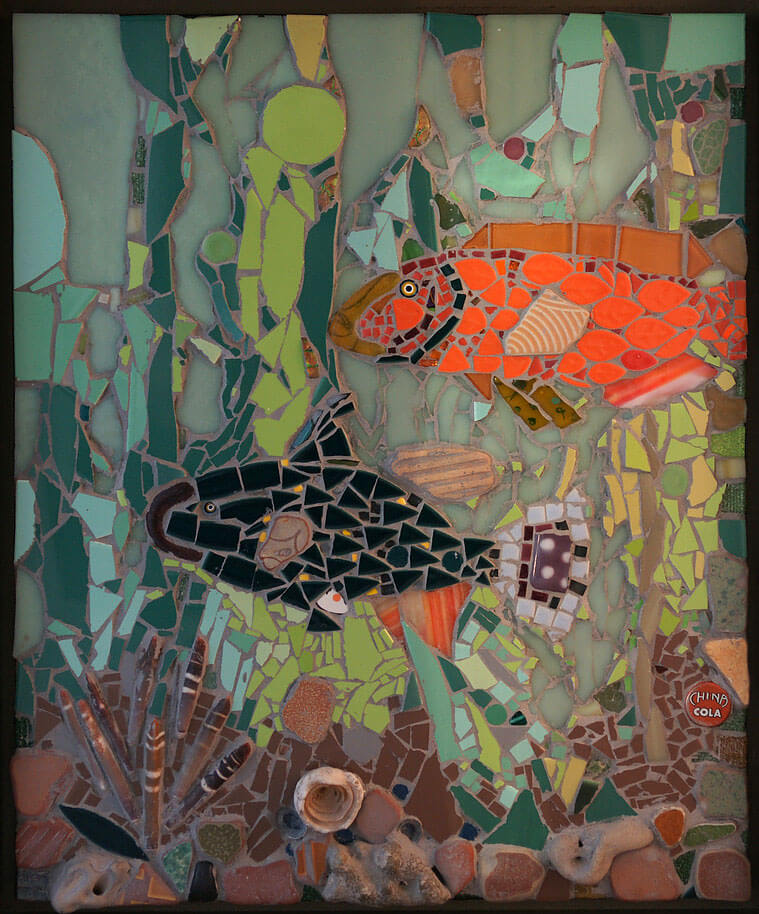
As far as I can tell, there is only one seashell fragment in the above sea scene. Just one.
The Right Found Object
I think symbolic found objects work best in figurative mosaic when they are used in a limited way (less is more) and when the object’s symbolic value doesn’t outweigh purely visual concerns and is the right found object of that type.
Some examples of what I mean:
Don’t use that toy train if it is bright and shiny and new, and the rest of the metal toys in the mosaic are old and rusty antiques.
Don’t use that tiny china doll head if it isn’t large enough to be in scale with the rest of the objects in the mosaic.
Take the time to get on eBay (or go to garage sales) and find a rusty caste-iron toy train or a large ceramic figurine’s head if that is what the mosaic really needs.
Don’t use the symbolic object you happen to have if it doesn’t really work visually due to scale or color or finish or degree of newness. It’s not a matter of “the thought that counts” or the symbolic value of the object. That particular object has to work visually, to fit in.
Avoid using newly-made whimsical cartoonish figurines in a mosaic where nothing else is whimsical or cartoonish or particularly modern looking.
Remember, the difference between great and mediocre art is in the last 5% of the details, and nothing will make the viewer realize that truth more than seeing a poorly-chosen symbolic object that could have been easily replaced with one more fitting for the mosaic.
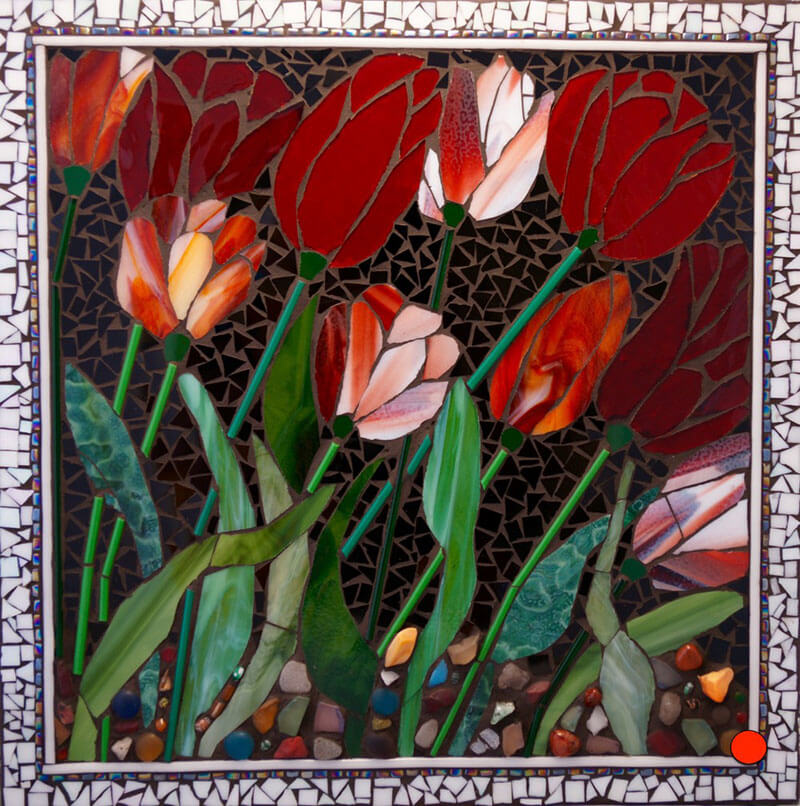
Less Is More
Look at how much visual interest is created in the above mosaic by the inclusion of just a little glass “gravel” toward the bottom. Notice how this little bit of gravel doesn’t extend up. Instead, a background of uniform black tile is used to ensure that the background doesn’t obscure or distract from the figures (the flowers).
I love making found-object mosaics that are completely covered with things like shells and fossils and artifacts, but when I see found objects being used in figurative mosaic, I’ve noticed that less is more.
For example, if you are making mosaic beach scene, consider using a few well chosen and well placed shells and compare how that looks to packing the beach with a larger number of shells.
Trust me, the eye sees them “more” in terms of their details when there are fewer of them.
Take the time to play around with the objects and arrange them in different configurations and orientations before you ever glue anything down.
If an object has a particular shape and meaning, it only makes sense to spend more time on its placement than you would on placing a generic tile.
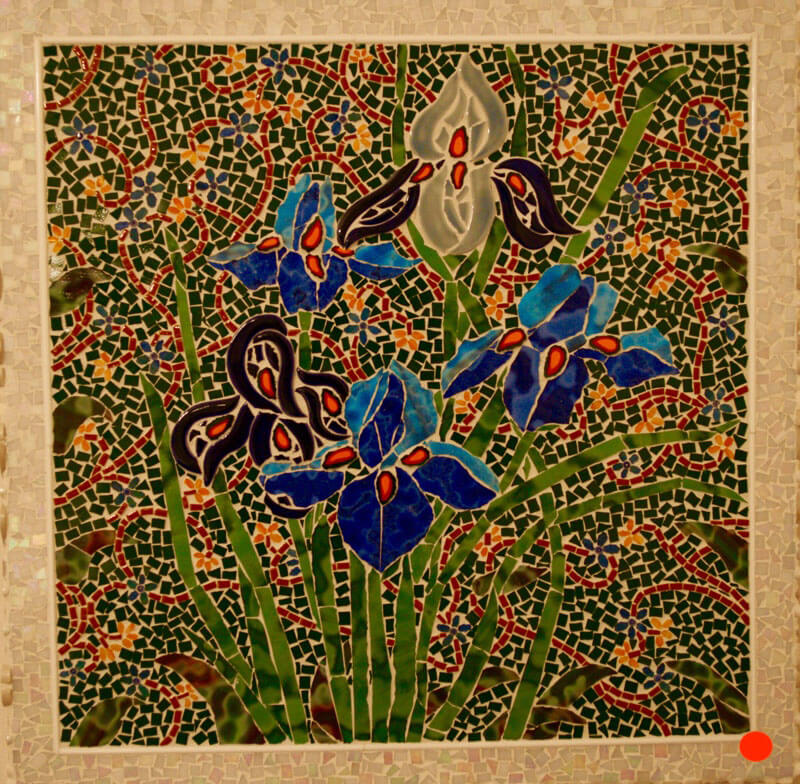
Mixed-Media
To me, Janet’s body of work almost seems like a tutorial of how to include found objects in a figurative mosaic without overwhelming or distracting from the image being rendered.
Consider the mixed-media mosaic above and notice how it doesn’t include any found objects (symbolic or otherwise), but it does use different types of mosaic glass (glass tile with stained glass), and it uses a single type of glass in different ways.
Look at the black tile background with red tile stems running through it. Notice how the black tile is more randomly placed, but the red tile is in more ordered and more tightly spaces rows. This contrast provides visual interest without overwhelming the central figures (the irises). The reason the irises stand out so well is because their stained glass is more solid visually.
I think if someone was interested in learning how to incorporate found objects in figurative mosaic, they could make a good start by using multiple types of conventional tile in different ways in the same mosaic.
Exceptions That Prove The Rule
Lastly, I wanted to point out a couple of Janet’s mosaics that work very well in spite of going against several of the principles I recommend on this blog.
Colored Grout
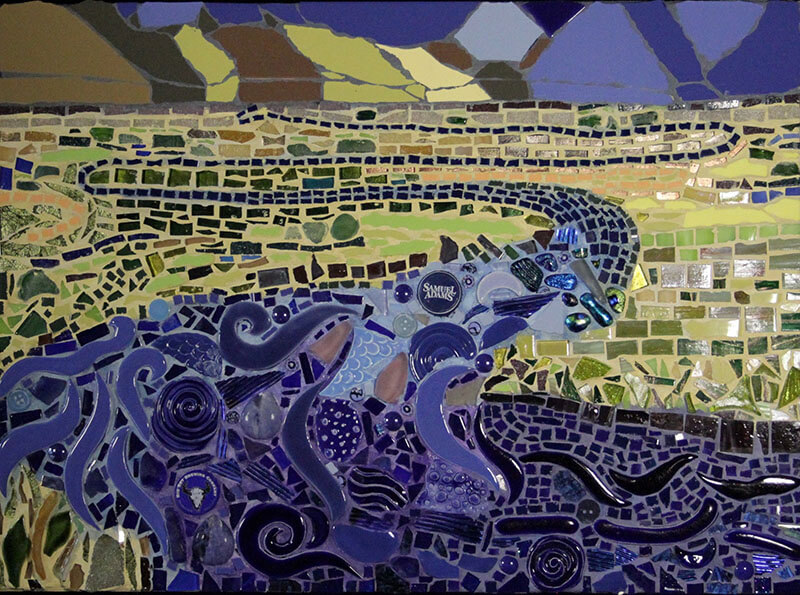
I generally recommend that people avoid grout as a source of color in a mosaic and that they provide the color with tile instead. I tell people to think of grout color as merely something to contrast tile color so that individual tiles stand out.
I also recommend that people stick to one color grout merely because it makes grouting much easier than trying to do different regions with different colors.
Janet’s mosaic above doesn’t do any of that. She has green grout with green tile and blue grout with blue tile. It works because the grout color is significantly lighter than the tile color in both cases. There is contrast of intensity between tile and grout instead of contrast of hue.
Coloring Your Grout
The easiest way to add bright colors to grout is to mix artists acrylic paint into traditional grout in a white or light gray color. I haven’t tested the outdoor durability of this mix, but the acrylic should add strength and longevity instead of decreasing the lifespan. Also, artist-grade paints are color fast and made from UV-resistant metal-oxide pigments.
Note that some mosaic suppliers sell powdered paint pigments, but we don’t due to safety concerns. Color-fast paint pigments are metal oxides that should not be breathed, and the risks of shipping damage and sloppy usage and disposal seemed too great to justify carrying them when acrylic paint was so readily available.
You can also use acrylic paint to change grout color on dry indoor mosaics AFTER the grout has hardened.
Here is an example of changing grout color with acrylic paint, and here is a case study that has the method for doing it at the end.
Light Colored Grout.
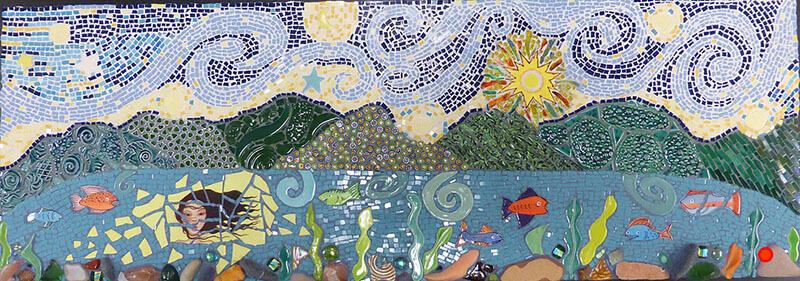
I generally recommend darker grouts and avoiding white grout entirely because white makes colors looked bleached out while dark grouts make colors pop.
In the mosaic above, Janet uses a light colored grout for the sky, but it is necessary for making the sky look lighter and more airy than the landscape beneath it.
Found Objects
If you are using rounded or oddly shaped objects in a mosaic, you should press them into a bed of thinset mortar spread on the backer instead of trying to glue them to it. Here are some instructions I wrote for using found objects in mosaic art.

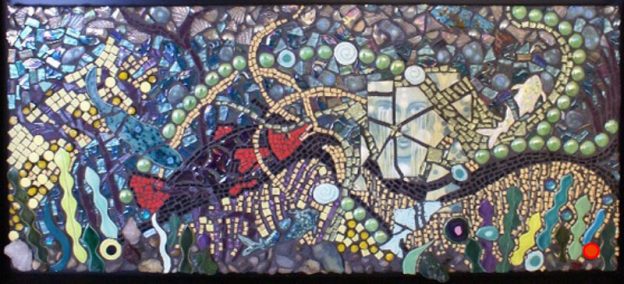
Leave a Reply